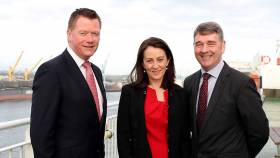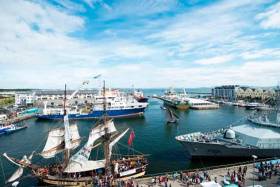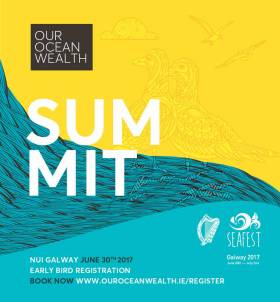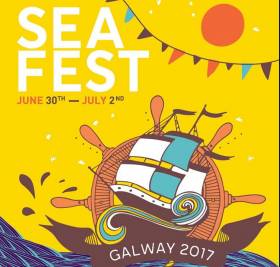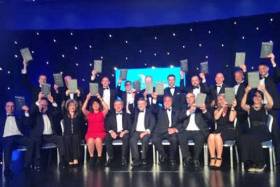Displaying items by tag: seafest
PwC Makes Sponsorship Deal For Our Ocean Wealth Summit
#OurOceanWealth - Professional services giant PwC has announced a new three-year headline sponsorship of the Our Ocean Wealth Summit, the fourth of which takes place in Galway next month.
The one-day summit on Friday 30 June at NUI Galway coincides with Ireland’s national maritime festival SeaFest 2017 in the City of the Tribes.
Speaking at the partnership announcement, PwC advisory partner Declan McDonald said: “Having worked with the Irish Marine Development Office for a number of years, we are delighted to formalise our partnership with them and assist the Marine Development Team and the broader Marine Institute to continue the great work they are doing in achieving the ambitions set out in Harnessing Our Ocean Wealth.
“Our seas are a vital national asset and very important to Ireland's future economic success, and the Our Ocean Wealth Summit provides a unique platform for the opportunities of our blue economy to be brought to the fore.”
McDonald added: “The opportunities for the blue economy do not come without challenges, both immediate in terms of the potential economic impact of Brexit on our ports and fisheries, but also in the longer term in terms of sustainable development and protection of our sensitive marine environment.
“We look forward to overcoming these challenges with Peter and the team in the Marine Institute bringing both local and global marine sector expertise from around the PwC network."
Marine Institute chief executive Dr Peter Heffernan said: “Ireland's marine sector has enormous potential for growth and our ambition is to be at the forefront globally as a leader in both traditional and emerging marine activities.
“PwC's support, as an internationally recognised leader in professional services, reaffirms this ambition and we look forward to working closely together to realise the potential of Ireland's marine economy.”
Renowned innovation expert Tom Kelley was confirmed in March to speak at the fourth Our Ocean Wealth Summit, which will also feature economist, writer and broadcaster David McWilliams; Miguel Marques, partner at PwC Portugal and Economist of the Sea; Terry Garcia, former vice president of National Geographic and CEO of Exploration Ventures; and many more.
Galway Business Backs Seafest Maritime Festival
Businesses across Galway and the region are giving their support to SeaFest 2017, with festival activities extending from Galway Harbour to The Latin Quarter and Salthill.
SeaFest 2017 is Ireland's national maritime festival and will include a variety of marine-themed activities and attractions to celebrate the sea from 30 June to 2 July 2017.
Dr Peter Heffernan CEO of the Marine Institute said the involvement of businesses across Galway and the region is vital to the success of SeaFest 2017.
"The marine sector is of major value to the Irish economy and coastal communities and offers significant potential for growth. It is essential for businesses, organisations and communities connected with our ocean to be part of SeaFest," Dr Heffernan said.
For the first time, SeaFest will welcome the contribution of the Western Development Commission (WDC) to the 2017 event.
"The WDC are delighted with the opportunity to participate in SeaFest," said Ian Brannigan CEO of the WDC. "At SeaFest we are setting out to showcase businesses in the West of Ireland who take their inspiration from Ireland's ocean. Mr Brannigan said.
The Galway Chamber of Commerce will also support SeaFest 2017 by working with businesses across Galway, particularly The Latin Quarter Galway and Salthill, to develop a programme of activities.
"Salthill offers stunning views of Galway Bay, and is the ideal location to feature water sports and hold family-friendly activities along the shore," Dr Heffernan said. "SeaFest is also an opportunity to highlight the host of quality eateries in The Latin Quarter Galway, including some of the city's finest seafood restaurants serving locally sourced produce."
As well as the three-day festival, a range of industry events will be held as part of SeaFest 2017. National and international delegates will attend Our Ocean Wealth Summit on 30 June at NUI Galway. Digital Ocean: Ireland's Marine Engineering and Technology Conference and the Marine Industry Awards will take place on 29 June. A Marine Trade Show will also be held at NUI Galway on 29 and 30 June, to run in parallel with the Our Ocean Wealth Summit and Digital Ocean events.
SeaFest is co-ordinated by the Marine Institute, on behalf of the Marine Coordination Group.
SeaFest Expands To Three-Day Celebration In 2017
#SeaFest - Organisers promise “a larger and more spectacular” SeaFest, as Ireland’s national maritime festival expands to include three days of activities and attractions celebrating the sea in Galway from 30 June to 2 July.
Festival chiefs met in Galway City Hall on Thursday 23 March to plan the SeaFest 2017 programme, intending to attract an even bigger number than the 60,000 who attended last summer.
“Galway Harbour will be a hub of activity for three days, featuring even more activities for children, aquatic displays, vessel tours, as well as exhibitions and entertainment,” said Marine Institute chief executive Dr Heffernan.
“Ireland’s marine infrastructure and resources will be on show, and visitors will also have the opportunity to celebrate our maritime history and discover more about our oceans.
“SeaFest also raises public awareness of the value of our marine resources and the economic benefits our ocean provides to Galway and all of Ireland’s coastal communities.”
Donal Maguire, Bord Iascaigh Mhara (BIM) director of aquaculture development Services, said BIM is delighted to be taking part in SeaFest 2017, promising the return of last year’s popular Big Top on the Docks.
“Our Big Top will be a wealth of family friendly fun information on all things relating to Ireland’s fishing, fish farming and overall seafood sectors, from cookery demonstrations to exciting interactive games and puzzles for the kids,” he said.
Naval Service vessel LÉ Niamh was popular with crowds last year, and an even bigger display is planned for SeaFest 2017. World-famous tall ship The Phoenix will again return to Galway Harbour, and visitors will also enjoy tours of Marine Institute vessels the Celtic Explorer and Celtic Voyager.
SeaFest 2017 is supported by BIM, the Department of Defence, Galway City Council, Galway County Council, NUI Galway, Bord Bia Irish Food Board, Port of Galway, Western Development Commission, Galway Chamber, The Village Salthill and Latin Quarter Galway.
Dr Peter Heffernan said collaboration with the festival’s partners is key to SeaFest’s success.
As well as the public festivities, the fourth annual Our Ocean Wealth Summit will be held on 30 June at NUI Galway. National and international delegates will discuss how Ireland is transforming its marine sector through new thinking to achieve economic prosperity and to protect marine resources for the future.
Early Bird Registration Now Open For Our Ocean Wealth Summit
#OurOceanWealth - Early bird registration is now open for the fourth annual Our Ocean Wealth Summit, which takes place on Friday 30 June at NUI Galway.
Global and national leaders from across the marine sector are set to convene and collaborate on innovating for our marine future, at this year’s summit, reflecting on innovation for a sustainable marine economy in a landscape of global turbulence and dynamic, disruptive technological, social and political change.
The summit is specifically targeted at national maritime stakeholders, from policy makers, industry representatives, and businesses to Government departments and agencies, NGOs, academics and researchers, and is increasingly attracting international attention.
In addition, the summit — an initiative of the Government's inter-departmental Marine Coordination Group — will review progress to date on Ireland's Integrated Marine Plan, Harnessing Our Ocean Wealth.
A full agenda for this year's Our Ocean Wealth Summit will be available in the coming weeks. Outline sessions include:
Session A: Progress on Harnessing Our Ocean Wealth
The objective of this session is to provide a platform whereby tangible progress towards the goals of Harnessing Our Ocean Wealth, the national maritime plan for Ireland, can be announced.
Session B: The Drive for Innovation
This session is intended to highlight to the audience the global context in which efforts to transform Ireland's marine industry must take place.
Session C: Smarter and Better
This session will examine how Ireland's established economic sectors, such as the food sector, can turn their attention to the sea. The session is designed to highlight that Ireland has key sectors of strength and expertise operating on a global playing field, which if matched to the marine resource, can be drivers for growth.
Session D: The Coastal Economy
This session will move the focus of the summit from the global perspective to one more focused on the Irish economy, using marine tourism and coastal enterprise as a case study to pose the question "How can Ireland innovate in marine tourism and leisure?".
Session E: Our Rapidly Changing Oceans
Designed to bring the summit full circle, this session will reflect on the ways in which innovation is possible and the benefits it can bring. Participants will also consider the overwhelming and urgent imperative to innovate arising from our changing oceans.
A number of related industry, innovation and research events will also take place on Thursday 29 June in advance of the summit, which is an integral part of Ireland's national maritime festival, SeaFest, in Galway from 29 June to 2 July.
To secure your place at this year’s summit, register now at www.ouroceanwealth.ie/register. See the website for more information or follow @OurOceanWealth on Twitter.
SeaFest 2017 in Galway Appoints Organiser for June Maritime Festival
Galway based and globally renowned event management specialist Arcana has been appointed to stage SeaFest, Ireland's national maritime festival, this summer. Arcana, which has organised sporting, cultural and commemorative historical events across the globe, has been given the challenge of staging what is fast becoming Europe's most exciting maritime festival. The company has won the contract to mastermind the programme for this year's extended SeaFest activities in the city dockland / waterfront.
Speaking of their appointment Johnny Donnelly, Managing Director of Arcana said: "We are delighted to have been appointed event managers for Seafest in 2017. We are really excited to be working with the various stakeholders and partners, both locally and nationally, on staging Seafest this Summer. At the heart of what we are planning is to make people's heart race with wonder and joy and also to stop people in their thoughts momentarily to reflect on the wonders of the waters that surround and nourish all our lives. Lots of shimmers and great waves lie ahead. We can't wait!"
SeaFest returns to Galway from 30 June to 2 July 2017. Last year more than 60,000 visitors flocked to the festival to enjoy an action packed programme of free family-friendly events at Galway Docks and an international conference at NUIG. The festival featured, among other events, Galway Hookers challenging for The Galway Plate, tours of the tall ship The Phoenix, seafood cookery demonstrations by celebrity chefs, interactive exhibitions and tours of the Marine Institute's research vessels.
SeaFest is an annual festival, celebrating all things maritime. An initiative of the inter-departmental Marine Coordination Group, SeaFest supports the goals of Harnessing Our Wealth – An Integrated Marine Plan for Ireland in relation to engaging with the sea.
SeaFest Returns To Galway In 2017 & 2018
#SeaFest - Ireland’s national maritime festival will return to Galway Harbour for the next two years, according to the Galway Independent.
The news follows the success of this summer’s SeaFest, which brought more than 60,000 visitors to Galway to see such attractions as tall ship The Phoenix.
Cork Harbour hosted the inaugural SeaFest in 2014 in tandem with the Our Ocean Wealth Conference, which will also return to Galway in 2017 and 2018.
The Galway Independent has more on the story HERE.
Second Annual SeaFest Nets 60,000 Visitors In Galway
#SeaFest - More than 60,000 visitors flocked to SeaFest, Ireland's national maritime festival, this past weekend to enjoy an action-packed programme centred on Galway Harbour.
Marine Institute chief executive Dr Peter Heffernan said he was delighted at the public response and at the enthusiasm for Ireland's marine heritage that underpinned the festivities.
"SeaFest is all about is increasing participation and engagement with the sea, showcasing Ireland's abundant maritime resources and celebrating our proud maritime heritage," he said.
"As the crowds in Galway showed, the sea is a fantastic source of fun and entertainment and we were thrilled to see so many people – locals and visitors alike – join in the spirited marine-themed fun."
Dr Heffernan added that the second annual SeaFest, following Cork Harbour's hosting of the inaugural event last summer, was "a hugely ambitious venture and Galway rose to the challenge of providing a fabulous weekend which both informed and entertained."
Among the scene-stealing excitement on the water was the spectacle of the Galway Hookers' challenge for the Galway Plate; the arrival of the gracious tall ship Phoenix; and Frank Bölter sailing his quirky large scale origami paper boat into the harbour in partnership with TULCA for Galway 2020.
On dry land, meanwhile, Bord Iascaigh Mhara and Bord Bia's seafood extravaganza was packed with natural produce and cookery demonstrations by celebrity chefs, alongside tours of ocean-going vessels and the Marine Institute's 'Our Wild Atlantic – What Lies Beneath' marquee with its interactive exhibits on marine life and creatures of the deep.
Significantly, SeaFest also brought to the city a major focus on research and the marine economy with a number of marine-related business and research events taking place in the lead-up to the public festivities.
The third annual Our Ocean Wealth Conference allowed speakers and delegates of national and international status to delve more deeply into the theme of 'Innovating for our Marine Future', exploring and strengthening Ireland's maritime heritage, economy and identity.
New Marine Michael Creed also welcomed the success of SeaFest, which ran from Thursday 30 June to Sunday 3 July and played host to 750 conference delegates from Ireland, Europe and the USA among the thousands of visitors.
Minister Creed, who spoke at the BIM Seafood Conference, the Marine Industry Awards ceremony and the Our Ocean Wealth Conference, said: “I was greatly encouraged by the energy and enthusiasm which I witnessed at the various events at SeaFest.
"The large attendance of delegates, the quality of presentations at the various events and the general desire to move forward the development of Ireland’s marine economy was very impressive.
"However, the huge response by the Irish people to the public events at SeaFest, with a record breaking 60,000 people attending on Saturday and Sunday, was the greatest testament to the high level of interest amongst the Irish public in all aspects of the marine.”
Minister Creed also launched the SmartBay Ocean Observatory, which will serve as a important element in the development of an Atlantic Ocean Observatory system and facilitate the test and demonstration of pilot-scale ocean energy devices in Galway Bay, before going on to further commercial development.
"The whole idea of SeaFest was to engage, examine and enthuse the public and policy makers about the potential for the development of our marine economy," said the minister.
"The Government strategy for the development of the marine economy is set out in the Harnessing Our Ocean Wealth integrated plan for the development of the marine in Ireland, and the success of last weekend’s SeaFest augurs well for the support and interest that exists to grow the marine economy in Ireland."
#BrexitImpact - Ireland's fishing industry will not lose out to agriculture in the wake of Brexit, the new Marine Minister assured stakeholders at this year's SeaFest in Galway.
Speaking to The Irish Times, Minister Michael Creed said "I am not going to shop one in favour of the other" amid concerns in the marine sector of a repeat of Ireland's concessions in favour of farming in negotiations to join the then EEC in the early 1970s.
As for what measures the Government will take to address the impact of Brexit, the minister said that "until Britain triggers the exit mechanism and lays its cards on the table, we can’t react".
Recently it was suggested that Britain's exit from the EU could create an opportunity for north Atlantic coastal countries – including Ireland and non-EU member Norway – to form their own economic group and take greater control of the region's fisheries.
The impact of Brexit is already resonating in the marine sector, as major Irish Sea ferry operator Stena Line, based in Sweden, confirmed it is "considering the implications for all of [its] UK interests".
Marine Industry Awards Recognise Excellence
#MarineAwards - The second annual Marine Industry Awards, hosted last night (Thursday 30 June) at the Radisson Blu Galway, saw Dr Dave Jackson of the Marine Institute named as Marine Industry Leader for 2016.
The Marine Institute was proud to sponsor four prestigious awards at last night's ceremony, held to coincide with SeaFest in the City of the Tribes.
These included the Excellence in Marine Technology Award, which went to Seagull Buoys – JFC Manufacturing, and the Excellence in Marine Education and Training Award presented to the Strategic Marine Alliance for Research and Training (SMART).
The Excellence in Marine Research Award went to the Coastal/Ocean Observing System, NUI Galway, while the award for Excellence in the Provision of Professional Services to the Marine Industry, sponsored by the Irish Maritime Development Office, went to GAC Training and Service Solutions.
Marin eMinister Michael Creed and Marine Institute chief executive Dr Peter Heffernan commended all the awardees on their success.
On Dr Jackson's award, Dr Heffernan said: "This award is a tremendous recognition of the significant role Dave has played in the development of the aquaculture industry both in Ireland and on an international level.
"I would like to personally acknowledge this achievement as a reflection of his career spanning over 30 years, dedicated to the advancement and expansion of the aquaculture industry."
The event was hosted by comic and broadcaster Colm O'Regan, with 19 prestigious trophies presented to the very best leaders and organisations operating across Ireland's marine industry.
According to the organisers, the Marine Industry Awards provide a voice for the individuals and companies that play a significant role in the growth and development of the industry in Ireland while recognising the key functions within the industry that promote growth and sustainability including manufacturing, port operations, logistics and commercial excellence to innovation, tourism and leisure, sustainability, aquaculture, education as well as many others.
Sea Change Research Providing Vital Marine Knowledge
#SeaChange - The Marine Institute yesterday (Thursday 30 June) hosted a number of research projects highlighting important achievements made by the Government's investment in the Sea Change strategy to build capacity, support innovation and ensure the quality of our marine environment.
"Funded research across all areas, from fisheries and aquaculture to marine environment and seafood health, demonstrates the government's commitment to developing Ireland's blue economy while also valuing the quality of our marine environment," said Ciarán Kelly, R&D manager at the Marine Institute, at the Sea Change Researchers Workshop to coincide with SeaFest 2016 and the Our Ocean Wealth Conference.
"This Sea Change research provides vital keys to unlocking our blue economy potential, while ensuring the quality and sustainability of the marine environment."
Over the last six years there has been an investment of more than €60 million in research supported by the framework strategy A Marine Knowledge: Research and Innovation Strategy 2007-2013.
This investment has funded hundreds of projects, study programmes and research scholarships for the marine sector.
Among the projects presented at the Marine Institute yesterday were an ecosystem approach to the management of fishery resources and the detection and testing of shellfish for toxicity azasparicids.
Research on ocean acidification and the genetics of wild salmon populations represent important research funded though the Sea Change programme.
A visual display of Sea Change projects showcased the variety and scale of projects funded, and a number of the Sea Change projects were recognised by the Beaufort Marine Awards held yesterday evening.
"The Sea Change research strategy also outlined the importance of developing skills and research capacity in the marine sector, and to this end, a number of research doctorates, scholarships and education programmes were also funded," said Dr Kelly.
Investment has significantly improved marine research capacity in Ireland, according to the co-ordinators of the Sea Change programme, who say it has strengthened Ireland's competitiveness in marine research and innovation and has supported the sustainability of the marine sector by developing greater alignment between the needs of industry and the research capacity of the public sector and third level.
A new National Marine Research and Innovation Strategy is being developed which will map the current state of research and innovation underpinning Ireland's blue growth potential.
This new strategy, to be published later in 2016, will identify the maturity and capacity of research areas and will be an aid to help focus future investment.


























